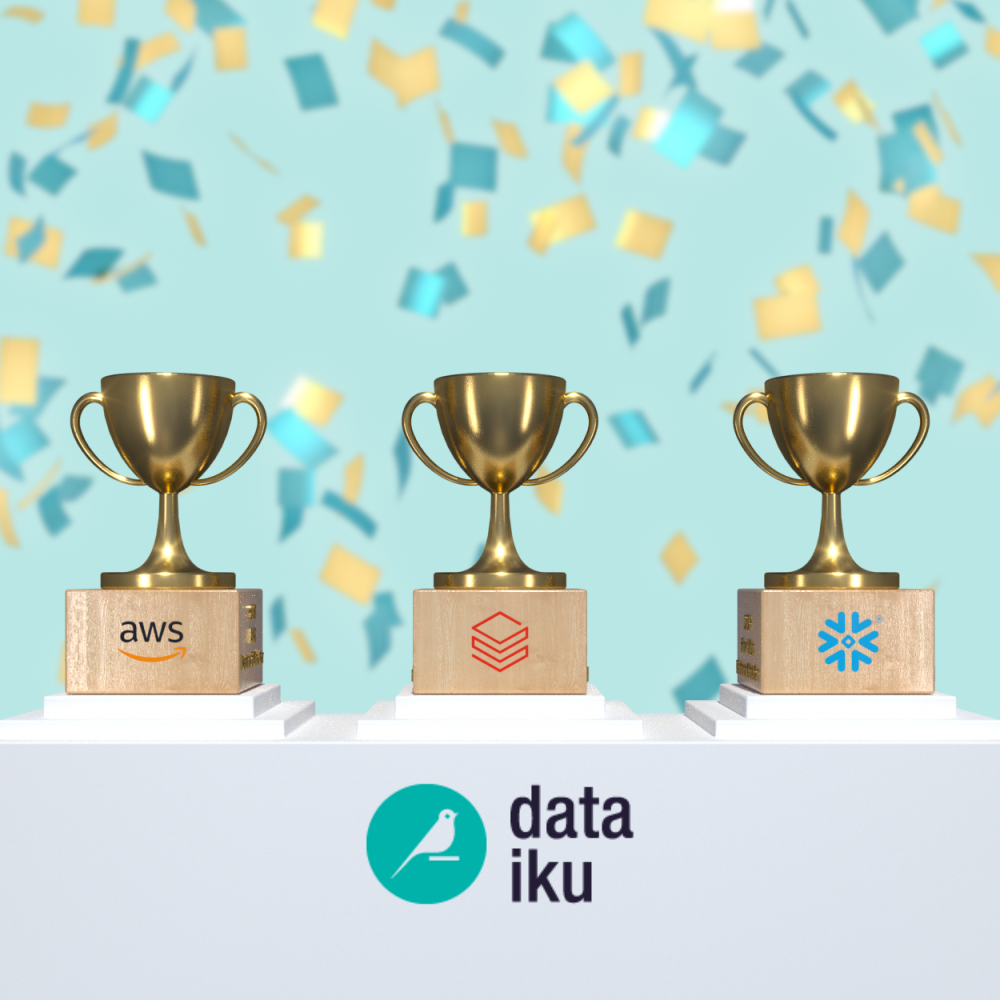This article was written by Mark Palmer, host of Executive Programs for Dataiku. Mark is a data and AI industry analyst for Warburg Pincus and a board member for six AI, data management, and data science companies. Time Magazine named him “A Tech Pioneer Who Will Change Your Life.” Mark is a LinkedIn Top Voice in Data Analytics.
Contrary to popular belief, success with AI isn’t about engineering or GPUs; it’s about how technology meets human creativity and leadership — a view held by C-Suite leaders from a new executive network from Dataiku called Exec Connect. Research shows that six percent of firms can ascribe 10%-20% of earnings and profits to AI — we can learn a lot from this six percent.
Here are seven secrets of how top-performing leaders help their firms get the most from AI.
1. Aim at "AI for All" (The Rise of Data Humanists)
“The way we think of software has to fundamentally change to empower every person on the planet to get the most from AI,” Satya Nadella told Sam Altman. Author George Anders found that seven AI-influenced jobs are being created for every programming job; millions of jobs each year are created or changed by AI. So, leaders must think more broadly about empowering their teams — all their employees, partners, and customers.
In “A Poet’s Perspective: Seven Reasons You Should Include an Analyst From the Humanities,” Erin Waldron argues that “data humanists” are the key to this transformation. These employees are deeply rooted in the humanities and grounded in AI. They use tools like Dataiku’s Universal AI Platform with low-code AI development tools
Erin argues that humanities education instills thinking that’s essential to AI success:
- Humanists are trained to be creative.
- Humanists have a passion for curation.
- Humanists have excellent communication skills.
- Humanists challenge what we think we already know.
- Humanists thrive on ambiguity.
- Humanists remember we’re studying predictably unreliable humans.
- Humanists are humble about what they don’t know.
Dataiku’s product strategy captures this idea. Everyday AI helps every employee develop agents and apps that leverage AI. The platform isn’t only designed for PhDs — it’s AI for all.
So, secret #1 is to pursue AI for all, not just data scientists.
2. AI Is a Camera, Using It Is Art
When still photography was introduced in the 19th century, the art establishment greeted it with disdain. In 1913, art critic Marius De Zayas wrote, “Photography is not art. Art is the expression of the conception of an idea. Photography is the plastic verification of a fact.”
AI is powerful and transformative, like a camera, yet some dismiss it, citing inaccuracies, hallucinations, or privacy concerns to ignore it.
But the tide is turning. Dataiku’s annual trends research found that 81% of C-suite executives have a moderate or high level of trust in using GenAI. But just as a camera captures what it’s aimed at, using AI is an artistic endeavor. AI can summarize documents, suggest better email phrasing, and make statistical predictions, but they’re only helpful if humans apply creativity, experience, and instinct.
A telecommunication company's call center uses AI to improve customer service via analytics. By analyzing agent call center conversations, they find ways to help agents be more empathetic, factual, or efficient and incorporate findings into training and tools to guide conversations in real time. In one instance, they uncovered a misunderstanding of a new pricing policy that increased revenue for that offer by over 50% when they re-explained it to agents.
So, view AI as a camera — a tool for expressing your business artistry.
3. Lots of Love for Lawyers
Top-performing AI companies love their lawyers more than laggards. A survey at Dataiku’s Everyday AI event found that Fifty-eight percent of high-performing executives said they involve lawyers early in making decisions about AI. Their reasoning: AI opportunity abounds, but so do risk, ethical concerns, bias, and fairness considerations. One executive put it this way: Fixing privacy, bias, and risks early is ten times easier than fixing them once you have a problem — with AI, you must “shift left” when considering the impact of using AI.
But lawyers aren’t just about risk avoidance; the best lawyers aim to accelerate the business. One IT executive said her legal team trained a large language model (LLM) to help her triage legal documents independently, translating legal ease into plain-language interpretations and giving her insight into proposed terms before involving legal. This proactive use of AI streamlines the business.
So, don’t delay: Even if you’re a high-performing AI company already, take your lawyer to lunch, brainstorm new ways to use AI and include them as early adopters, not just a risk manager

4. Reckon About the Coming Agent Reckoning
In 1960, Nobel Prize and Turning Award winner Herbert Simon wrote, “Machines will be capable, within 20 years, of doing any work that a man can do.” Sixty-five years later, some forms of AI are showing remarkable progress in Turing Test-like evaluations. Yet, scant few leaders view its output as replacing good human judgment.
Nevertheless, the hype about agentic computing abounds. AI agents can act independently to produce human-like responses for call center management, anomaly and security breach detection, or even create synthetic users that research shows achieve 85% accuracy in simulating the responses to interviewees for tasks like surveys, product research, and behavioral studies.
But, said one CIO, they still work for us. While agent simulation can augment ideation, research and discovery, high-performing AI leaders still view agents as interns — lower-cost, scalable, and occasionally inaccurate members of a team that help achieve scale that require careful oversight; they elevate, not replace, human judgement.
Secret #4 is that leaders engage early with agentic computing but don’t shoot for autonomous agents — yet.
5. Use AI Like a Snowball
Another key to AI success is using it as an ever-growing data analysis asset. Like a snowball rolling downhill, absorbing what it encounters, growing bigger and more powerful. Some would think business intelligence (BI) has increased power and value like a snowball. Yet, industry analysts estimate that fewer than 30% of employees use BI dashboards like Tableau or Power BI. Contrast that with the rise of GenAI, which is already used by twice as many people in companies on average (50%). At Dataiku’s Exec Connect sessions, some report over 90% of their employees use GenAI every week.
However, high-performing AI companies know that using GenAI is not a static proposition. One executive deployed GenAI to help teams interpret regulations. As his analysts monitored use, they noticed employees ask questions about product pricing, competitive intelligence, and organizational structure. He established a monthly “Rank, Rate, Add” meeting to rank questions, rate their importance, and add data to their LLM where possible. Like a snowball rolling downhill, they pick up new questions each month and grow their LLM Q&A corpus.
So, the fifth secret of high-performing AI leaders is to grow it like a snowball rolling downhill, picking up questions on its path.
6. Growing Agentic Analysts
At Dataiku’s Exec Connect Roadtrip event in Boston, an EVP of analytics at a top-tier bank said that she redirected 25% of her BI team to train agents. She explained that BI analysts understand users' questions and are best placed to incorporate them into LLMs and agents. Agentic intelligence helps spot insights that normally require reactive BI.
To explain how, she used a classic exercise from BI guru Steve Wexler’s book, “The Big Picture.” Steve’s exercise presents a raw table of numbers to illustrate how ineffective design leads to confusing, inaccurate interpretation. By prioritizing key questions and adding color highlights to show top and poor performers (best performers in blue, poor performers in orange, below left) the time to answer questions of this data is reduced from minutes to seconds with 100% accuracy instead of 80%.

She then shows how the same questions can be answered autonomously, by an agent, once the analyst trained it on the key questions to answer. By injecting agents with these questions, her analysts speed time to insight and democratize access to insights with a push-based model: When the agent finds a significant change in the answer to a question, it’s sent to interested parties.
Secret #6 is that leaders are starting to turn their view of BI on its head with AI. Analysts are the key to train agents on which insights matter. Like good dashboard design, good agent design helps deliver insights faster and better.
7. It's the HCI, not the AI
When Steve Jobs launched the iPhone in 2007, he spent 42% of his time (almost four minutes out of nine) on what he felt was its most crucial breakthrough: Using your finger for Human-Computer Interaction, or HCI. It was the new style of interaction that he was most excited about, not the screen, circuits, and software inside the device. If Jobs launched GenAI as a new Apple product today, he would probably spend 42% of his time on prompting — the ability to understand human questions, reason, and generate answers with immense depth, power, and accuracy. High-performing AI leaders view the HCI model as the most powerful innovation of AI.
Prompting changes the human-to-AI interface in a way that radically changes how analytical jobs are done. Any task using BI dashboards, spreadsheets, or applications is a candidate for prompt-based interfaces. For example, check out Dataiku’s latest innovation that helps you talk to your data, called Dataiku Answers. It makes it easier to break down the barrier between human questions and data-driven answers.
Secret seven is to look for ways to change the relationship between business questions and their answers using prompt-based interfaces and to use tools that break down human-to-computer barriers to power Everyday AI.
Success With AI Is Where Human Creativity Meets Silicon Smarts
These seven secrets of AI leadership remind us that lowering the barrier between human creativity and leadership are the essential drivers of AI's potential, not only technological prowess. By empowering all employees with the right tools, using AI for business creativity, and flipping your view of HCI on its head, organizations can begin to harness the full transformative power of AI.




